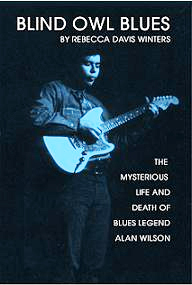Alan “Blind Owl” Wilson. The name itself evokes a particular aura. It whispers of prodigious talent intertwined with profound fragility. While Canned Heat’s boogie-infused blues-rock ignited the late 1960s, Wilson, their enigmatic guitarist, remains a figure shrouded in both adulation and sorrow. This is not just another rock and roll tragedy; it’s a multi-layered narrative of musical genius, crippling insecurity, and a desperate yearning for connection with both humanity and the natural world.
Considered a virtuoso by many, Wilson’s distinctive high-pitched tenor and intricate guitar work became hallmarks of Canned Heat’s sound. Songs like “On the Road Again” and “Going Up the Country” catapulted them to international fame, embedding them in the counterculture zeitgeist. But behind the stage lights and the roar of the crowd, a different reality played out. Wilson battled inner demons that ultimately proved insurmountable. What drove this deeply sensitive soul to such a tragic end?
Early Life and Musical Genesis: A Prodigy Emerges
Born in Boston, Massachusetts, in 1943, Alan Wilson displayed an exceptional aptitude for music from a young age. The clarinet was his first instrument, later gravitating to the guitar. Immersing himself in the blues, he meticulously studied the styles of legendary figures like Robert Johnson and Son House. This dedication wasn’t mere imitation; Wilson absorbed the essence of the blues, translating it into his own unique idiom. He played in various bands around Boston, honing his skills and developing his signature sound. These formative years were not without their struggles, however. Wilson was a highly introverted individual, often feeling like an outsider. His poor eyesight, which earned him the nickname “Blind Owl,” further contributed to his feelings of isolation.
Canned Heat: From Local Scene to Woodstock Stardom
In 1965, Wilson’s path intersected with that of blues enthusiast Bob Hite, and Canned Heat was born. The band quickly gained traction in the burgeoning Los Angeles blues scene, attracting attention with their authentic sound and energetic performances. Wilson’s instrumental prowess and distinctive vocals became integral to their identity. Their self-titled debut album in 1967 showcased their raw talent. Subsequent albums, like “Boogie with Canned Heat,” solidified their position as a major force in the blues-rock movement. Of course, their electrifying performance at the Woodstock Music and Art Fair in 1969 cemented their place in rock and roll history. But even as Canned Heat reached the zenith of their popularity, Wilson’s internal struggles continued to intensify.
The Weight of the World: Environmentalism and Existential Angst
Wilson possessed a profound connection with the natural world, a deep-seated environmental consciousness that was remarkably prescient for his time. He was acutely aware of the ecological damage being inflicted upon the planet, and this awareness weighed heavily on his soul. He channeled this concern into his music, advocating for environmental protection through his lyrics and actions. This intense sensitivity extended beyond environmental issues. He was deeply troubled by social injustice and the suffering of others. This empathy, while admirable, became a burden, contributing to his already fragile mental state. The pressures of fame, coupled with his inherent anxieties, began to take their toll.
A Descent into Despair: Mental Health Challenges and Isolation
Wilson’s struggles with mental health were exacerbated by his shyness and social awkwardness. He found it difficult to connect with others on a personal level, often retreating into himself. He was known to be incredibly self-critical, constantly questioning his abilities and worth. His bandmates and friends tried to support him, but his deep-seated insecurities proved difficult to overcome. He experimented with drugs and alcohol as a means of coping with his anxieties, but these substances only served to exacerbate his problems. The constant touring and the demands of the music industry further isolated him, leaving him feeling increasingly alone and disconnected. The cumulative effect of these factors pushed him further down a path of despair.
The Final Days: An Untimely Demise and Lingering Questions
On September 3, 1970, Alan Wilson was found dead in Topanga Canyon, California. The official cause of death was an accidental overdose of barbiturates. He was only 27 years old. The circumstances surrounding his death remain a subject of speculation. Some believe that his death was a deliberate act of suicide. Others maintain that it was a tragic accident, a result of his ongoing struggles with addiction and mental health. Regardless of the specific cause, Wilson’s death was a devastating loss for the music world. It robbed us of a brilliant talent and a compassionate soul. It also served as a stark reminder of the devastating impact that mental health issues can have on individuals, even those who appear to have it all.
Legacy and Remembrance: Beyond the Boogie
Alan “Blind Owl” Wilson’s legacy extends far beyond his musical contributions. He was a visionary artist, a passionate environmentalist, and a deeply sensitive human being. His music continues to inspire and move listeners around the world. He represents the archetype of the tortured artist, grappling with inner demons while simultaneously creating beautiful and meaningful art. His story serves as a cautionary tale about the importance of mental health awareness and the need for compassion and understanding. By remembering his life and his music, we can honor his memory and strive to create a more supportive and empathetic world for those who struggle with similar challenges. His influence permeates contemporary music, a testament to the timeless quality of his work and the enduring power of his message. He may be gone, but his music and his spirit live on.
